
How to Grow Apples: The Full Planting Guide
Published: 10/02/2023 | Updated: 29/03/2023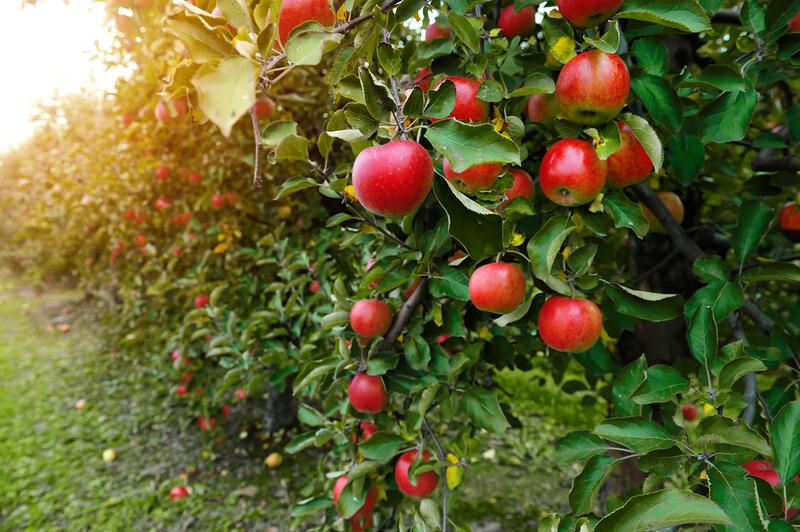
Nothing beats a homemade apple crumble or maybe some apple pie for thanksgiving. Now imagine that delicate desert made with homegrown apples from your backyard apple trees. What a dream right? Let's make it a reality with our full guide on how to grow and care for your apple trees right in your backyard!


General Apple Tree Information
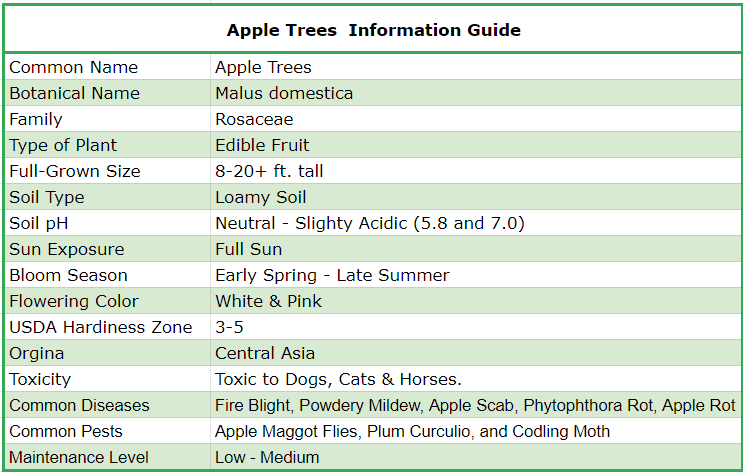
About Apple Trees
Apple trees are not only for those with vast tracts of property. You may grow a healthy harvest of apples even in a small area by planting an espalier or a hedge of dwarf apple trees. In the central and northern regions, planting in the spring is advised. Only in regions with typically milder and moister autumn and winter weather may fall planting be successful.
Where Do Apple Trees Grow
However, growing apples requires careful consideration of the climate. If an apple tree is described as "hardy," it typically thrives best in USDA Hardiness Zones 3 to 5. The greatest zones for apples, if they are considered "long-season," are Zones 5 to 8.
Many catalogs, as opposed to tree tags, will inform you where the variety grows best. It takes a certain number of cool hours for each variety's fruit to set (the time the temperature is between 32- and 45 degrees F). An apple cultivar needs more chill hours in the north than in the south to prevent problems with late spring freezes. To find out the chill hour, look at the tree tags or speak with the seller.
Apple Tree Planting Needs
Tons of light and lots of drainage are right up front!
Apples, like the majority of fruit-producing plants, need as much sun as possible to grow to their optimum potential. They will require at least six hours of direct sunlight each day, ideally in a place that shields them from the worst summer afternoon sun.
Apple trees will flourish when planted in well-drained soil that doesn't become too moist. They should never be planted in low-lying or rainy areas; bald cypress and willows should do that instead!
The apple tree should be placed on a slope in the north or east, close to the summit, and in a sunny area. You have drainage and sunlight, which is a wonderful place to start.
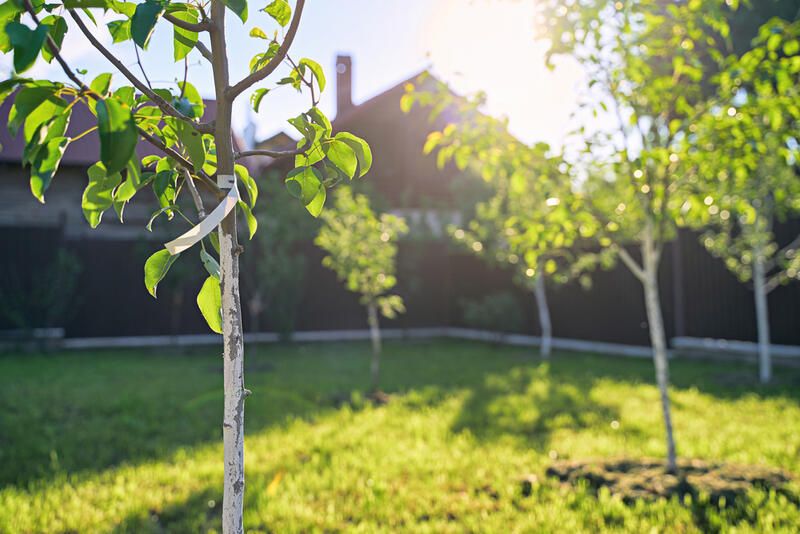
Room to Grow
There are two varieties of apple trees: full-size and dwarf varieties.
Dwarf apple trees often reach heights of four to eight feet, and full-size trees can reach heights of twenty to thirty feet. Both sizes have advantages and cons.
Dwarf trees are more tightly packed and smaller. Many are perfect for growing in an espalier fashion.
Even while they often produce less fruit than larger cultivars, they nevertheless occupy much less space in the backyard. Additionally, you can accommodate more trees in a given space, offering a larger range of flavors and extended availability times for fruit. They are also simpler to harvest from.
Unfortunately, the root systems of dwarf trees are frequently weaker. Strong storms make them more prone to being blown over, and high fruit production may even cause them to fall over. Grow these small trees next to a fence or with strong support.
The roots of full-sized trees don't have the same problems, but because they are bigger, they take up more room. You'll need to prune these trees with ladders, pole clips, and a fruit picker in exchange for a substantial yield.
Dwarf apple trees, in contrast, are perfect for a casual gardener or someone who doesn't like to perform a lot of trimming. For the more dedicated gardener or the person with the necessary space and motivation, full-size trees are available.
How Far Apart to Plant Apple Trees
Dwarf trees should generally be planted four to eight feet apart, while every tree has varied requirements for spacing. For enough room to grow, full-size trees require fifteen to eighteen feet between them. Plants should be no more than 50 feet apart to pollinate one another.
Soil & Fertilizer Requirements
Apple trees certainly require good drainage and a lot of suns, but at least they don't require rich soil! They often thrive in medium-quality soil, neither too rich nor too deficient.
Apple trees don't need fertilizer when they are originally planted. They don't require any nutritional supplements until they have been in operation for two to four years. The precise figure here relies on the cultivar you've selected and the timing of your tree's ripening.
You should feed the tree a nitrogen-rich fertilizer after it begins to bear fruit in the spring. This is because apples begin consuming a lot of nitrogen once fruit production starts.
It's wise to follow the "just enough" rule when applying fertilizer. Refrain from the urge to overfeed your plants, and only fertilize when necessary.
After July, it is strongly advised against fertilizing apple trees because any new growth is vulnerable to damage later in the season.
It is fine to put a little amount of compost in the springtime along the drip line of your apple tree, followed by a nitrogen boost after fruit production starts.
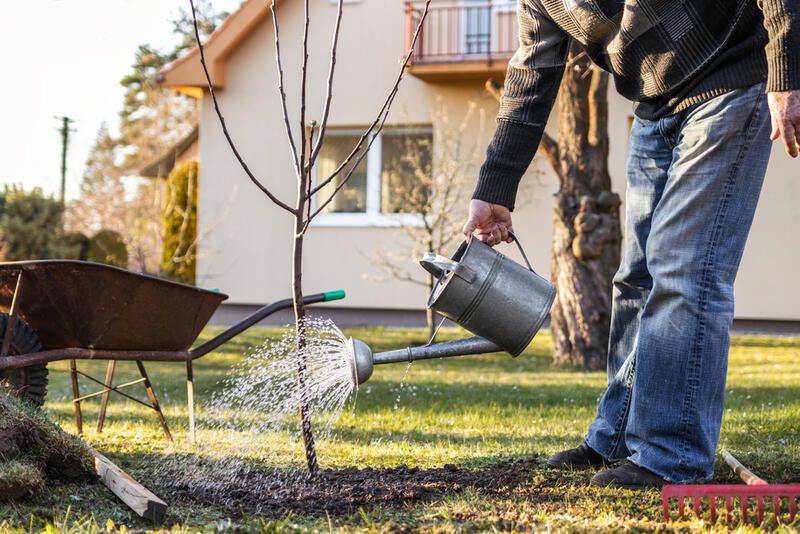
Choosing the Right Variant for You
You can grow organic fruit or use fewer chemicals if you choose disease-resistant trees like "Liberty," "Jonafree," "Macfree," and "Williams Pride." Also, upkeep is simpler.
You must decide on a rootstock. Every apple tree marketed consists of two parts: the "scion," or top piece, which defines the fruit type, and the "rootstock," or base. A rootstock might be "dwarfing" or "size-controlling," or it can be "seedling" or "normal," which results in a full-size tree (which produces a smaller tree for easier care and harvest).
Make sure the rootstock is mentioned for miniature trees. For USDA Climate Zones 3 to 5, a Bud 9 tree is a typical, hardy, and simple-to-train tree. Although it could perish in harsh winters, the M9 rootstock is probably the one that is planted the most.
Purchase dormant, bare-root, nursery trees that are one year old with sound root systems. In 3 to 4 years, dwarfs and semi-dwarfs will bear, producing 1 to 2 bushels annually. A tree of average size will bear fruit in 5 to 8 years and produce 4 to 5 bushels of apples annually.
Based on fruit attributes, bloom time, and pollen compatibility, an apple variety should be chosen. To find out whether trees in your neighborhood might cross-pollinate, speak with a nearby nursery. Include a "Grimes Golden," "Golden Delicious," "Red Delicious," or "Winter Banana" in your planting for the greatest results. These plants are recognized pollinators. If crabapple trees blossom at the same time as the desired variety, they can serve as pollinators as well. Pollination charts can be found in nursery catalogs.
It is necessary to plant at least two different apple tree varieties adjacent to one another for bees to be able to pollinate them. Most apple varieties do not pollinate themselves or any flowers of the same apple variety. If you're truly pressed for space, there are apple tree kinds that can self-pollinate. Even these apple trees, though, will produce more fruit if they are cross-pollinated.)
Additionally, think about how you'll use your apples: Do you enjoy making apple pies? Or maybe you simply prefer apples that taste better than those you may get at the supermarket. For more details, go to the best apples for baking.
-
About 1 1/2 bushels of fruit are produced by a young dwarf tree; this number drops even further if the tree is a part of an apple hedge. So, to get enough fruit to make enough apple pies, you'll need to plant numerous trees of that particular variety.
-
If you don't have any specific culinary objectives, consider growing one of each variety that ripens during the full harvest season. This way, you can still keep enough fruit on hand for a "mess" of cooked apples while still taking part in frequent apple tastings.
-
Consult with local orchardists to learn which types will thrive in your region. Do the majority of your planning while sitting in an easy chair and holding six nursery catalogs in your lap!
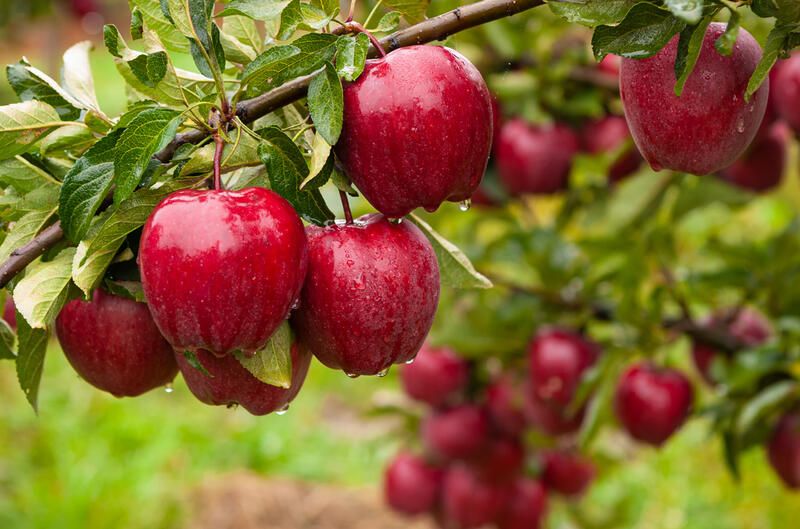
Growing Apple Trees from Seeds
Is it possible to grow a tree from a seed of a variety you want rather than purchasing a young tree? This is a popular query. Although it is possible to grow an apple tree from a seed, the apple tree you end up with is probably not what you were hoping for!
The genetic makeup of apple seeds varies from that of the parent tree, so characteristics like tree growth, hardiness, and fruit quality will vary (and will usually be poorer). So you won't get Honeycrisp apples if you plant a Honeycrisp seed. You might have to wait a while because it can take an apple seedling 8 to 10 years to get big enough to start producing apples.
Even so, nurturing an apple seedling can be an enjoyable experiment.
How-To
Before they are prepared to germinate and flourish, apple seeds need to be exposed to cold, moist circumstances. The natural seasonal cycle will take care of the seed's chilling requirements for you if you sow them outside in the fall at a depth of 1/2 inch. Alternatively, you can put the seeds in the sand that has been moistened and store them in a plastic jar in the refrigerator for 3 to 4 months. Once the risk of frost has passed, plant them outdoors 1/2 inch deep. As soon as the seedling appears, make sure to water it frequently and keep pests away.
Planting Nursery Trees
Choose the Right Location
Apple trees, like the majority of fruit, produce their best when they are grown in full sun, which is defined as six or more hours of daily direct summer sunlight. Apple trees need soil that drains properly but can still hold some rainfall. The best soils have a light to medium texture. Fruit trees struggle in dense clay soil, and the disease root rot is brought on by poorly drained soils.
Fruit trees should be planted in areas with sufficient air circulation to ensure that leaves dry off fast after irrigation or rain (or the tree risks fungal leaf diseases)
Check to make sure the tree won't be planted in a "frost pocket," which is a place where cold air collects in low-lying areas. If you can, pick a higher location with a slip so that cold air can move away from the trees. Avoid planting trees close to other trees or in wooded regions.
Although a pH range of 5.5 to 7.0 is acceptable, 6.0 to 6.5 is the preferred range for soil. Before you plant your apple trees, test the soil.
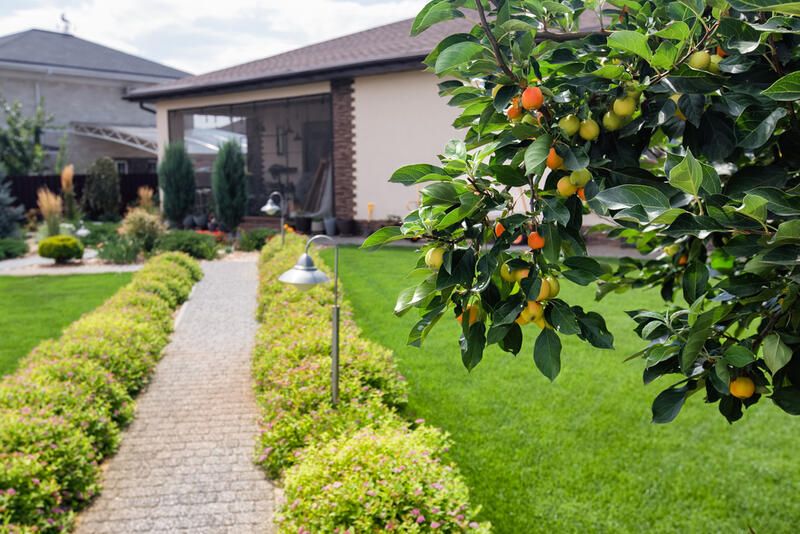
Planting Apple Trees
Remove all weeds and the grass in a 4-foot-diameter circle before planting. Protect the tree against damage, drying out, freezing, or overheating after you've bought it. About 24 hours before planting, bathe the roots in water if they are dry.
The rootstock, soil fertility, and pruning all affect tree spacing. In a row, seedlings or mature trees should be spaced roughly 15 to 18 feet apart. A row of dwarfing rootstocks may be spaced 4 to 8 feet apart. A different cultivar that blooms at the same time must be planted within 2,000 feet of apple trees if they are to cross-pollinate (preferably, nearer).
Make a hole that is 2 feet deep and roughly doubles the size of the root system. Refill the planting hole with some of the loose soil after loosening the soil on the walls so the roots can readily pierce the soil. Make sure the tree roots are not twisted or crammed in the hole by spreading them out over the loose soil. Continue adding soil to the area around the roots. Firm the dirt as you start to cover the roots to make sure it completely encloses them and to get rid of any air pockets. Fertilizer shouldn't be added when planting because it can "burn" the roots. The loose soil should now be used to fill the remaining space in the hole.
Apple trees are typically grafted. To prevent roots from growing from the scion, the graft union needs to be at least 4 inches above the soil line. The swelling at the junction marks the graft union, where the scion is joined to the rootstock. You should support your hedge since dwarf apple trees are notoriously prone to uprooting under the weight of a hefty yield. You can allow your trees to grow up a fence or use a trellis to offer free-standing support.
Growing & Caring for Your Apple Tree
Young trees should be watered often to ensure a strong root system, especially those on semi-dwarfing or dwarfing rootstocks. Replace mulch as needed, but keep it separate from the trunk to prevent rot. This aids in avoiding rats using it as a winter nest and gnawing on the tree's bark.
For apple trees to support high apple crops, the trees must first receive training to develop a sturdy structure of branches. Dwarf plants need to be trained to a central leader system and supported with posts or trellises. A modified leader should also be trained into standard (and semi-dwarf) trees.
A significant component of care will be pest control techniques. To prevent hurting the bees and compromising pollination, timing is crucial. Pesticides are sprayed as necessary and not by the calendar, but rather at a particular period of flower and fruit development. Knowing which pests are most likely to be an issue will help you apply the appropriate controls at the appropriate time. It is crucial to research your variety and climate.
It is feasible to avoid pesticides, even though apple trees are one of the fruits that are most vulnerable to pests. For instance, although this requires some time and work, you may wrap each apple on your tree in paper bags. There are organic pesticides as well.

Pruning
Apple trees require regular pruning, whether it's for fruit production or merely to maintain a pleasant appearance.
The best time of year to prune an apple tree is in the spring, ideally before it begins to set leaves. When trimming apples, the fundamentals still hold, but there are additional details to consider:
When approaching apple trees, it's best to first distinguish between structural pruning and maintenance pruning.
Maintenance Pruning
This requires a little more self-assurance in your trimming abilities.
You should first get rid of the water shoots. These are the slender, whip-like growths that rise directly up. Cut these off hard and close to the branch.
Branch crossings come next. Have you ever observed how some branches begin to grow backward toward the stem rather than away from it? Two branches may occasionally cross over one another. To improve ventilation and fruit production, we want to prune the rival branches and open up the tree.
By taking care of these competing branches, we encourage the existing limbs to produce more fruit.
Structural Pruning
When structurally pruning, weak limbs are the first thing to go since the trees need strong limbs to bear fruit. The ideal limb posture for fruit growth is 45° away from the trunk, or the "ten and two" angles we are accustomed to when holding on to the driving wheel.
Remove weak twigs and any dead ones. The likelihood that a branch may eventually need to be cut off increases with the number of years the branch has been producing fruit. The same rule applies to any harmed, ill, or dying wood: remove it!
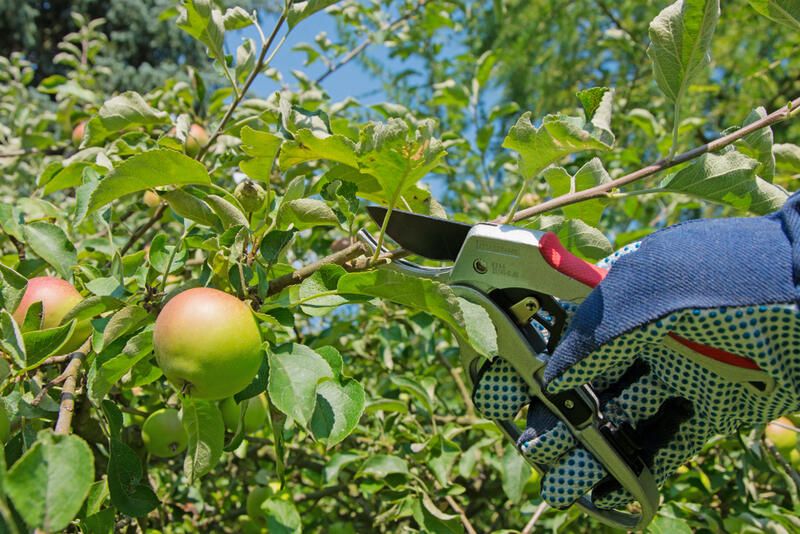
Improving Your Harvest
You should thin out the fruits on the branches once they start to mature. The removal of soon-to-be apples appears paradoxical to have a larger harvest, and you could be left wondering why you are doing it.
Well, consider the costs involved in producing fruit. A tree can only generate a certain amount of energy to support the growth of its fruit. If that energy is dispersed over 500 apples, you'll get a lot of underdeveloped, unimpressive fruits.
However, if we eliminate the weakest fruits—those that are smaller, cracked, and consuming precious resources—we will have a harvest of, say, 200 apples—but they will all be sizable, healthy, and delicious fruits.
Thinning out your seeds and deadheading flower blooms that have already bloomed are examples of the same concept applied to a different situation.
Aim to maintain a distance of about four inches between each surviving apple until the fruit begins to develop and you are removing the weaker, smaller, or cracked apples. This ensures a healthy crop of produce and appropriate airflow.
Picking Your Apples
Do you know what to look for to know when it's time to harvest now that the fruit is about ready to be picked? We want to check the fruit's color, how simple it is to remove it from the branch, and the hue of the seeds inside.
Apples typically ripen from top to bottom and from the edge of the tree to the middle. How quickly the fruits will ripen for picking depends on how much sun they receive. Check your fruit if you start to notice a few apples that have fallen to the floor.
The Color
If you don't mind the fruit being a little bit tarter, it's best to wait until all of the green has disappeared from an apple's skin before harvesting.
When the apples are not completely ripe, certain trees produce fruit with a sour flavor. (We prefer that in a fruit however not everyone will enjoy this.)
Picking Ease
Grab some fruit by reaching up and taking it. It's not ready to be harvested if you can't remove it with a light pull. To make sure you didn't find a stubborn stem, try a couple of different fruits.
Avoid yanking or pulling the fruit. We don't want the tree to be damaged, which you can do.
The fruit ought to have a slight softness to it. The unripe fruit is firm, whereas the ripe fruit's flesh has a little give to it.
You should be able to tell the difference between ripe and unripe fruit because they can be as hard as rocks.
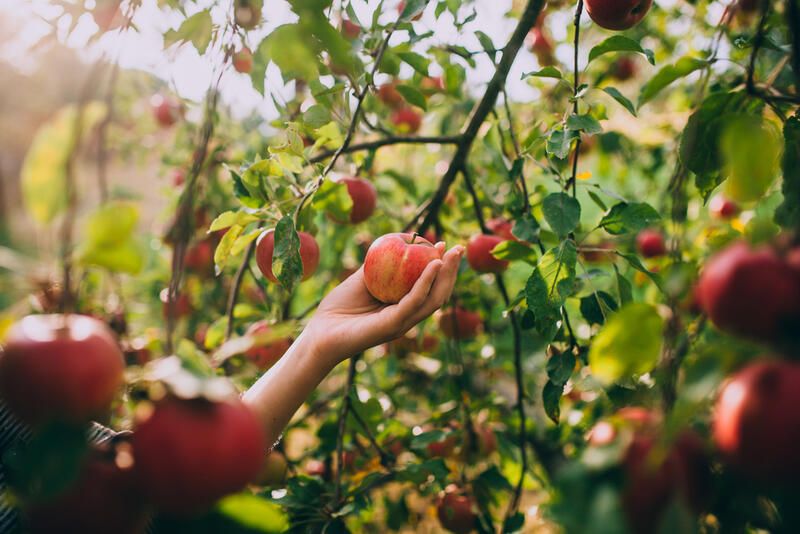
Seed Colors
Ripe apples contain hard, dark-brown seeds inside, but seeds in developing fruit are pale or greenish. This test requires the sacrifice of fruit, yet it provides a reliable indication of fruit ripeness.
To discover what's inside an apple, carefully cut it in half using a sharp knife.
Pest & Disease Control
Apples are susceptible to a variety of pests and illnesses, such as codling moths, plum curculios, green fruit worms, and apple maggots. Many gardeners who swear to avoid pesticides discover that to produce a respectable harvest, they must at least find an acceptable annual spray treatment.
Choosing disease-resistant types like "Prima," "Priscilla," "Liberty," and "Freedom" is one way to avoid using pesticides. For apple scabs, cedar-apple rust, and other common diseases, they do not require spraying, in contrast to the majority of other kinds, which do so after planting every spring and summer. To learn about approved pest prevention methods in your area, contact your extension agency.
Storing Apples
Only keep apples that are mid or late-season. Early season types are best consumed right away because they don't keep well. While late-season types can last up to five months in a root cellar, mid-season kinds should only keep for a few weeks. Apples intended for storage must be flawless, free of any dents or flaws that could act as rot entry points.
Apples can be stored by being individually wrapped in newspaper or tissue paper. Lay out the covered apples on trays with ventilation. The fruits shouldn't contact when they are unpacked or stored. Keep the different varieties apart and consume the ones that won't keep as long first. Different varieties keep for different amounts of time.
A place that is cool, dark, and well-ventilated makes for the ideal store. Attics and basements should be avoided due to either extreme heat, a lack of circulation, or low humidity. The majority of garages and sheds are ideal. Regularly inspect apples in storage and discard any that are turning soft, brown, or rotten.
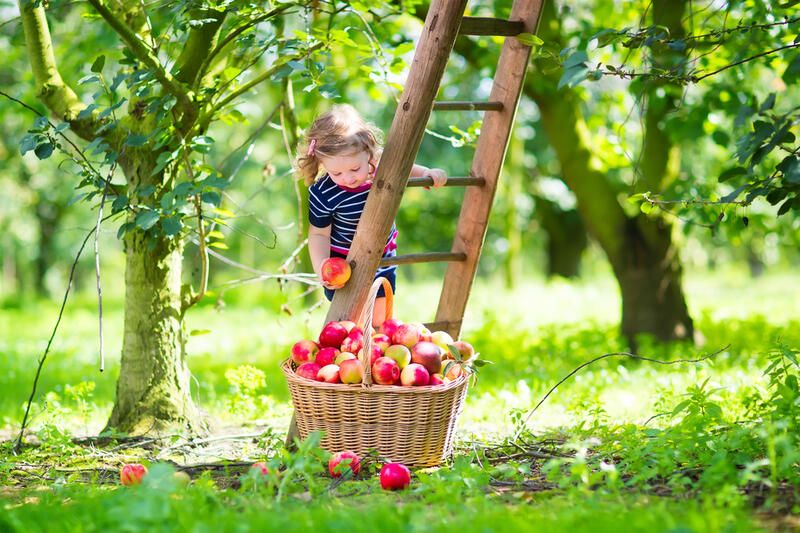
Cooking Tips
You can freeze apples by stewing scrubbed chunks with a dash of water until they soften. When done, sift the stewed apples and place them into freezer-safe containers, leaving a tiny space at the top because they will expand somewhat when frozen.
You can also make a pleasantly chewy and healthful snack by slicing your fruits into thin slices and drying them in a dehydrator.
Do you intend to bake or sauté your apples to make an apple pie or other dish? Check out some recipes online!


